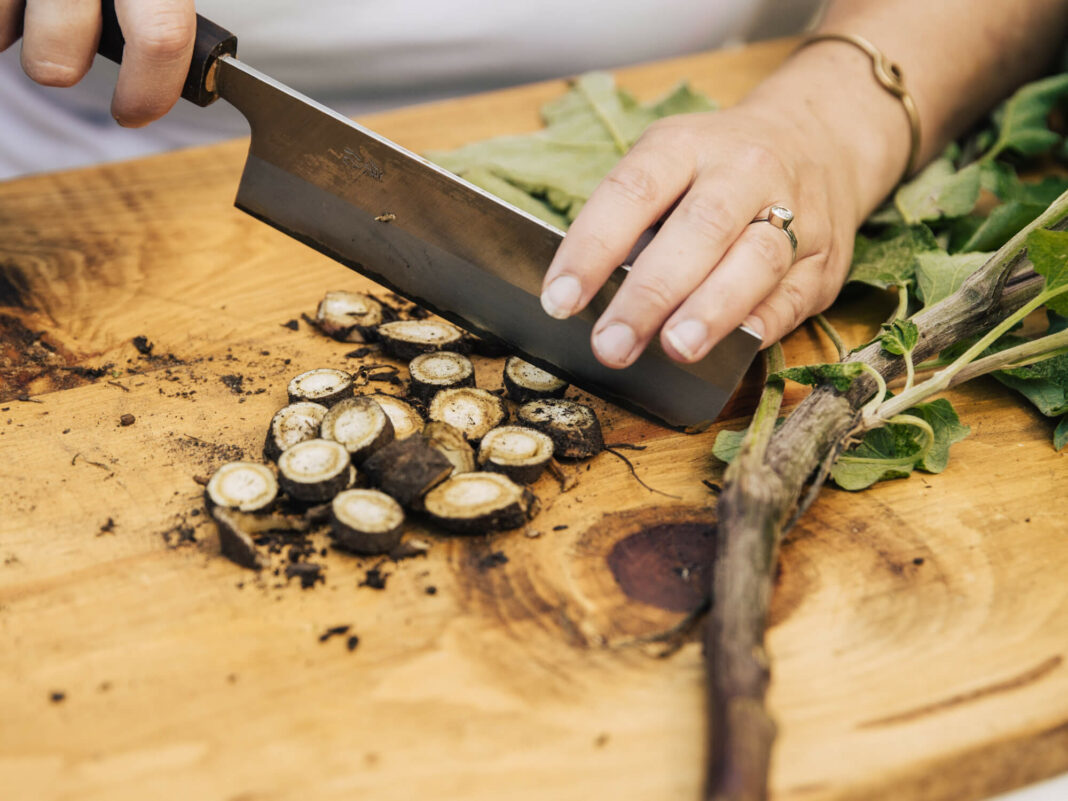When I picture our microbiome, I see great herds like the zebra and wildebeest that populate the savannah: this is what the flora is, really, more than a garden. It’s a series of waves of intermingling populations, and instead of the grasses of the savannah, the foundation of their food chain comes from what we eat, along with healthy layer of mucus. In return, just as the herds that travel north to south in a seasonal search for water, the bacteria and fauna fluctuate across our guts and contribute to a healthy ecology all through the GI tract. Just as the plains of the Serengeti would fail without the great herds, so too our gastric mucosa relies on a long history of balance with its inhabitants: they are a single ecology. And since we’ve learned more and more about how much impact this ecology can have on our moods, our immunity, and of course on our digestion, it makes sense to think about how to keep it functioning well.
Herbs have been perennial companions, and some of the earliest evidence comes from starchy herbs (like Dioscorea, a genus that includes yams and found on kitchen vessels from 30,000 years ago) that straddled the line between medicine and food. The microbiomes of our ancestors, if modern hunter-gatherer populations like the Tanzanian Hadza are any indication, varied seasonally and responded, in part, to the availability of these roots and tubers. They were, and still are, rich in digestible carbohydrates as well as prebiotic starch. While we can’t digest this starch directly, it is an important source of nutrition for the microbial ecology. These days, prebiotic starches are still just as vital, and we rely on a few key plants that provide an abundant, varied source to support a thriving microbiome. With all of them, start slow at first to see how your digestive system reacts, and take them around mealtime – they are very food-like.
Slippery Elm. This is the inner bark of Ulmus rubra, and is so named because of the rich, slimy mucilage it produces when mixed with water. This mucilage is slippery to the touch, soothing, and loaded with prebiotic starch. We can’t break down these chains of rhamnopyranose and galacturonic acid, but they support a healthy mucous layer in the GI tract and serve as food for beneficial bacteria, too. You can mix the powder into tea, brewed at a relatively low temperature (180F), or to cooked grains like oatmeal after they’re off the heat. Its mild flavor makes it a favorite way to get your prebiotic fiber. Use between two teaspoons and two tablespoons a day.
Codonopsis. The root of this beautiful vine is often steam-treated, and tastes a little smoky as a result. Its rich complement of starches and prebiotic fiber have made it famous in Traditional Chinese Medicine, where the herb is considered a “spleen qi tonic”, able to support good digestion and assimilation. Its starch includes inulin-like fructans that seem able to support healthy microbial populations in the GI tract. If you want to go beyond just soothing, Codonopsis is a good choice based on its extensive traditional use and indications. One to three teaspoons a day of the powder approximates the doses used in Traditional Chinese Medicine, and in liquid tincture form we often suggest 60-90 drops two or three times a day.
With a touch more bitter flavor, roots from the _Asteraceae_ like dandelion and burdock also provide a good amount of prebiotic starches, though lean more towards shorter-chain compounds like inulin, a fructo-oligo-saccharide (FOS). These are still good food for our microbial flora, but the added touch of bitterness also supports healthy secretions across the gut – a fantastic combination for digestive health.
Dandelion (Taraxacum). The classic digestive tonic also includes a good amount of inulin and other prebiotic starches, especially if harvested in the fall. This clues us in to one of the reasons plants make these molecules to begin with: they are long-term energy storage, often concentrated in the roots so that in spring the plant has reserves it can use for new green growth. But for us, fall-harvested dandelion roots can be coarsely chopped and roasted over low heat for 5-10 minutes, or until a nutty aroma develops. These roasted roots make a valuable tea, brewed with one tablespoon per cup, or added to French press or drip coffee-makers. Dandelion root is an especially good companion to your probiotic supplement or fermented foods.
Burdock (Arctium). You can eat these big roots just as you would a carrot: stir-fried, grated into salad, or simmered into soup, burdock brings a delicious, mildly bitter and earthy flavor to your dishes. It’s also great pickled or brined. But for the microbiome, you’d be hard pressed to find a richer source of inulin and prebiotic starch. Traditionally, herbalists relied on burdock to support healthy skin, and part of the reason lies in this herb’s ability to build a healthy microbiome and provide gentle, bitters-based detoxification, too. While a tincture, taken in doses of 1/2 teaspoon two or three times a day, has good bitter tonic qualities, you’ll want the whole root in food-like doses to maximize the benefit to gut flora. One large root (eight inches long or so) is a good daily amount. The equivalent dose of powder is high: three or even four tablespoons per day is not unreasonable. But even in smaller quantities (one or two teaspoons), burdock root can be mixed with grains or infused into tea and helps give flora the food it needs.
Finally, sometimes even well-established migrations can get off course. Plants in the Berberidaceae, a botanical family rich in deeply-yellow pigments often concentrated in the roots, provide us with a tonic action traditionally used to support great digestion. The Eclectic physicians of the 19th century held up herbs like goldenseal or barberry as restorative tonics, often used as “alteratives” for healthy skin and good liver function as well as gut health. These herbs are quite bitter, too, due in large part to the same alkaloid that brings the yellow color: berberine (and some derivative molecules). These days, we know that berberine supports a normal, healthy balance of organisms in the microbiome, and also that it can help keep the connections that link cells, connective tissue, and fascia of the intestines strong and healthy. This is a good combination that addresses both the “field” (cells and mucosa) and the “herds” (bacterial populations).
Goldenseal (Hydrastis). This classic tonic is often the starting point for microbiome-support protocols in my herbal clinic. It comes from shady spots on the Eastern seaboard, all the way to Ohio and down south through Appalachia. Because of its popularity over the years, it is considered an at-risk botanical and should be used sparingly, and for short periods of time. It’s a good thing then that its dose (about 1/4 teaspoon two or three times a day) is so low, and that you often take it for two weeks or less. If you want to try goldenseal root, beware its strongly bitter flavor, and mix the powder with a little water. Or consider the tincture, still quite useful despite its low starch content, at doses of 15-45 drops.
Oregon Grape Root (Mahonia). The west-coast plant from the forest understory is often touted as an alternative to the at-risk goldenseal. But it’s an excellent herb in its own right, bringing good balance to the microbiome and also supporting great liver function and bile production. It is quite bitter, like all its berberine-rich cousins, making a tincture the easiest way to experience its benefits. Try 60-90 drops, in a little water, twice daily before meals. As a bitter tonic, you’ll see relief from the common, mild symptoms of digestive upset. But as a berberine source, Oregon grape root is hard at work for a great microbiome, too.
The strongly bitter herbs of the Berberidaceae can be a powerful way to begin your journey of microbial support. After experiencing them for a week or two, it’s time to start thinking about some of those rich sources of prebiotic starch, either alongside grains, in tea, or mixed with smoothies or juice. Think about simple additions like burdock root, roasted dandelion root tea, or Codonopsis powder. You don’t need too much, but the regular presence of prebiotics alongside natural ferment as part of your daily routine brings a familiar context back to the teeming ecology that lives inside our bellies. They’ll thank you for it – and you will appreciate the results!
Top 5 This Week
Related Posts
Top 6 herbs for your microbiome – Urban Moonshine

